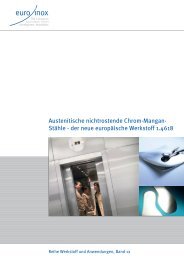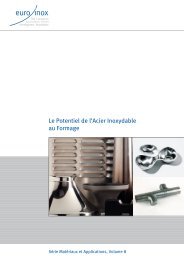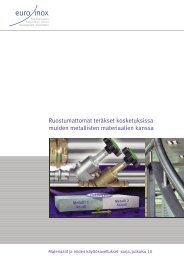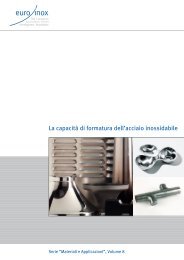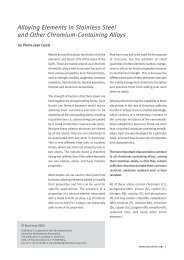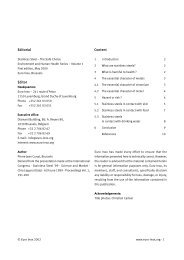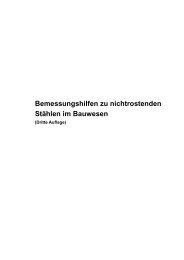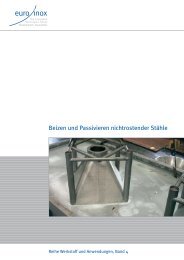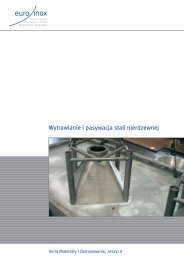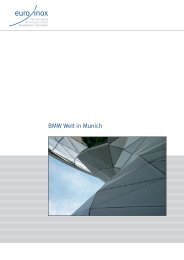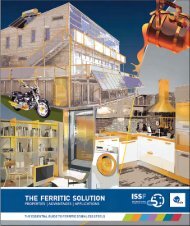Innovative Stainless Steel Applications in transport ... - Euro Inox
Innovative Stainless Steel Applications in transport ... - Euro Inox
Innovative Stainless Steel Applications in transport ... - Euro Inox
You also want an ePaper? Increase the reach of your titles
YUMPU automatically turns print PDFs into web optimized ePapers that Google loves.
Table 38. Airborne emissions from the diesel eng<strong>in</strong>e of a bus <strong>in</strong> short-distance (city) traffic<br />
(Mäkelä 2008). Cons. = fuel consumption.<br />
Emission class<br />
CO NOx PM CH4 NMHC N2O SO2 CO2 Cons.<br />
(g/km) (g/km) (g/km) (g/km) (g/km) (g/km) (g/km) (g/km) (g/km)<br />
EURO 3 0.6 9.7 0.21 0.03 0.10 0.035 0.0042 1340 423<br />
EURO 4 0.5 6.8 0.04 0.03 0.06 0.035 0.0042 1340 423<br />
EURO 5 0.5 3.9 0.04 0.03 0.06 0.035 0.0042 1340 423<br />
The <strong>in</strong>dustry associations of steel and sta<strong>in</strong>less steel producers have collected materialsproduction<br />
LCI data. These <strong>in</strong>ventories are available for use <strong>in</strong> Life Cycle Assessment<br />
(LCA) studies. They all give a “cradle-to-gate” po<strong>in</strong>t of view, <strong>in</strong>clud<strong>in</strong>g efficient<br />
recycl<strong>in</strong>g. The recycl<strong>in</strong>g ratio of ferrous metals for <strong>Euro</strong>pean end-of-life vehicles is<br />
between 98 % and 99 %, while 1-2 % goes to waste as metal landfill (Beck 2004, Ridge<br />
1998). Bus frames are fairly easy to dismantle and recycle.<br />
6.3. Life cycle cost evaluation of bus-frame materials<br />
The life cycle cost of a bus frame <strong>in</strong>cludes the materials and manufactur<strong>in</strong>g costs of the<br />
frame and the operat<strong>in</strong>g costs. Bus-frame structures are manufactured us<strong>in</strong>g welded<br />
hollow sections and sheets. The difference between carbon steel and sta<strong>in</strong>less steel<br />
frames is that a carbon steel frame must be completely pa<strong>in</strong>ted, to protect the welded<br />
hollow sections from corrosion. Long frames need a large dip-pa<strong>in</strong>t<strong>in</strong>g tank, which<br />
implies a correspond<strong>in</strong>g capital <strong>in</strong>vestment. The chromium content of sta<strong>in</strong>less steels,<br />
however, ensures adequate corrosion protection and removes the need to pa<strong>in</strong>t frames.<br />
This gives sta<strong>in</strong>less steel an advantage <strong>in</strong> terms of manufactur<strong>in</strong>g costs.<br />
The operat<strong>in</strong>g costs of a bus frame are largely determ<strong>in</strong>ed by fuel consumption and,<br />
therefore, frame weight. Lower operat<strong>in</strong>g costs can therefore reduce the life cycle cost<br />
of a lighter bus. Figure 71 shows how significant fuel costs are, compared to materials<br />
costs. This is why the curb weight of a bus is important <strong>in</strong> the quest for low life cycle<br />
cost with reduced operat<strong>in</strong>g costs.<br />
112



